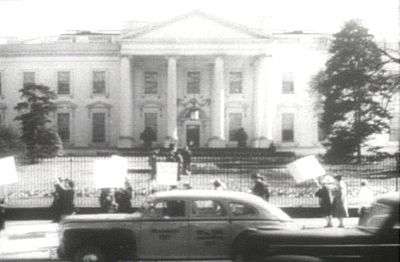American Peace Mobilization
The American Peace Mobilization (APM) was a peace group established in 1940 to oppose American aid to the Allies in World War II before the United States entered the war. It was officially cited in 1947 by United States Attorney General Tom C. Clark on the Attorney General's List of Subversive Organizations for 1948, as directed by President Harry S. Truman's Executive Order 9835.

Organizational history
Establishment
The American Peace Movement (APM) was launched as the "Emergency Peace Mobilization" at a Chicago convention during Labor Day weekend during September 1940, a gathering attended by about 6,000 delegates.[1] The group was formed from remnants of the American League for Peace and Democracy, an anti-war organization funded by the Communist International and controlled by the Communist Party, USA which attempted to build an American–Soviet defense alliance against potential aggression in Europe on the part of Nazi Germany—an organization terminated with the signing of the Molotov–Ribbentrop Pact of August 1939.
With the Soviets seemingly protected by what was viewed as a stable treaty of non-aggression with Nazi Germany, the Soviet Union's focus turned from overt anti-Fascist militancy to "peace," and the members of the various national groups affiliated with the Comintern followed this change in lockstep.
The Chicago convention adopted a platform called "Five Planks to Defend America,"[1] which instead of organizing to stop the spread of fascism included demands to:
- Keep Out of War
- Defeat Militarism and Regimentation
- Restore the Bill of Rights
- Stop War Profiteering; and
- Guaranteed a Decent Living Standard for All
In conjunction with these goals, the APM was particularly active in attempting to halt military conscription, and sought to serve as a Communist-led "mass organization" that sought to bring together trade unions, student groups, women's organizations, and anti-war church organizations under a single organization.[1]
In the midst of the London Blitz and the Battle of Britain, APM also agitated for a cut-off of "warmonger" President Franklin Roosevelt's Lend-Lease program, and any other U.S. aid to the U.K.[2] The group conducted a 1,029-hour non-stop peace demonstration in front of the White House, a protest which ironically ended on June 21, 1941—one day before the Nazis invaded the Soviet Union.[3]
Policy reversal
With the Nazi invasion of the Soviet Union, the pro-Soviet activists within the APM again reversed their previous agenda almost overnight, now demanding immediate U.S. entry into the war.[4] APM changed its name yet again, to the American Peoples' Mobilization.[5] While the Communist Party and its various "pro-peace" front organizations completely reversed their position on the war the moment the pact was violated, the non-interventionists of America First continued their opposition until the U.S. was attacked on December 7.
National Committee to Win the Peace
During the Cold War, the group rediscovered pacifism as the National Committee to Win the Peace in demanding nuclear disarmament, and U.S. and British withdrawal from Palestine, China, the Philippines, and Greece.[6][7]
Personnel
The Executive Secretary of the APM was Frederick V. Field, formerly the head of the Communist-sponsored American Council of the Institute of Pacific Relations. Field was the author of two book-length treatments of American investment and financial exploitation in the Far East and was editor of the monthly magazine Amerasia.[8] Field was joined in the national office in Washington, DC by Administrative Secretary Marion Briggs and the following group of formal officials:
- John B. Thompson, Chairman
- Theodore Dreiser, Vice Chairman
- Jack McMichael, Vice Chairman
- Vito Marcantonio, Vice Chairman
- Reid Robinson, Vice Chairman
- Katherine Terrill, Vice Chairman
- Max Yergan, Vice Chairman
Footnotes
- "The Story of APM," in Committee on Un-American Activities, House of Representatives, Investigation of Un-America Propaganda Activities in the United States: Appendix — Part IX. Washington, DC: US Government Printing Office, 1944; pg. 434.
- "Picketers Picketed," Time, June 2, 1941.
- "White House Pickets Stop At 1,029 Hours," Washington Post, June 22, 1941
- Purely for Peace, Time, July 14, 1941
- American Peoples Mobilization Collected Records, 1940-1941, Peace Collection, Swarthmore College.
- The First Loyalty, Time, March 31, 1947
- Win the Peace for Whom? Time, September 16, 1946, (What is a Front?, response from BGen. Evans F. Carlson)
- "APM National Officers," in Investigation of Un-America Propaganda Activities in the United States: Appendix — Part IX, pp. 434-435.